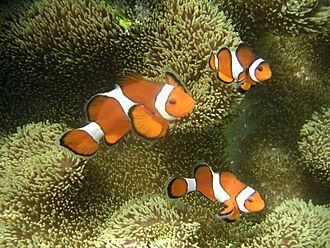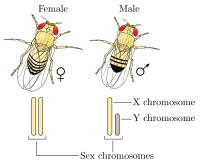Sex determination facts for kids
Sex determination is how a living thing's biological sex (whether it's male or female) is decided during its development. Many living things reproduce by having two individuals of the same species come together.
Usually, males and females are separate. But sometimes, one individual can have both male and female parts. This is called being a hermaphrodite. You can find hermaphrodites in some animals, like snails, and in most flowering plants.
The sex of an organism can be decided in two main ways:
- Genetically: This means it's determined by the genes and chromosomes the organism gets from its parents.
- Environmentally: This means something outside the organism, like temperature, triggers its development into a specific sex.
Contents
How the Environment Decides Sex

For many species, the environment plays a big role in deciding sex. This often happens during their early development.
Temperature's Role in Sex
Many reptiles, like some turtles, have their sex decided by the temperature around them. This is called temperature-dependent sex determination. The temperature of their eggs during development determines if they will be male or female. For example, in some turtles, cooler temperatures produce males. Warmer temperatures produce females. This difference can be as small as 1 or 2 degrees Celsius!
Changing Sex Over Time
Some fish can actually change their sex during their lives. This amazing process is called sequential hermaphroditism. For clownfish, the smaller fish are male. The largest and most dominant fish in a group will become female.
In many wrasse fish, it's the opposite. Most wrasse are born female. They become male when they reach a certain size. These fish can produce both male and female reproductive cells over their lifetime. But at any one time, they are either male or female.
Hormones in the Soil
Even some ferns can have their sex influenced by the environment. Normally, ferns are hermaphrodites. But if a fern grows in soil where other hermaphrodite ferns have been, it can be affected by leftover hormones. These hormones can make the new fern develop as male instead.
How Genes Decide Sex
The most common way for sex to be decided is by genes. This means an organism's sex is set by the genome it inherits. The specific genes that control sexual development are often found on special chromosomes. These are called sex chromosomes.
Because genetic sex determination relies on these chromosomes, there's usually an equal number of male and female offspring.
Different Genetic Systems
There are several ways genes can determine sex in different species.
XY System
Humans and other mammals use an XY sex determination system. In this system, the Y chromosome carries the instructions for male development. If there is no Y chromosome, the default sex is female. So, individuals with two X chromosomes (XX) are female. Individuals with an X and a Y chromosome (XY) are male.
This XY system is also found in other organisms. These include the common fruit fly and some plants. In some cases, like the fruit fly, it's actually the number of X chromosomes that decides sex. The Y chromosome might not be as important.
ZW System
Birds have a different system called the ZW sex-determination system. Here, the W chromosome carries the instructions for female development. If the W chromosome is missing, the organism will be male by default. So, individuals with two Z chromosomes (ZZ) are male. Individuals with a Z and a W chromosome (ZW) are female.
Most butterflies and moths also use the ZW sex-determination system. In both XY and ZW systems, the sex chromosome that carries the key instructions is often much smaller. It usually has only the genes needed to trigger the development of that specific sex.
XX/XO System
Many insects use a sex-determination system based on how many sex chromosomes they have. This is called XX/XO sex determination. The "O" means there's no second sex chromosome. All other chromosomes in these insects come in pairs. But they might inherit one or two X chromosomes.
For example, in crickets, insects with only one X chromosome (XO) develop as male. Those with two X chromosomes (XX) develop as female. In a tiny worm called C. elegans, most worms are XX hermaphrodites. But sometimes, worms with only one X chromosome (XO) appear. These XO individuals are fertile males.
Haploid-Diploid System
Other insects, like honey bees and ants, use a haploid-diploid sex-determination system. In this system, individuals with a full set of chromosomes (diploid) are usually female. Individuals that develop from unfertilized eggs have only half a set of chromosomes (haploid) and are male. This system means the sex of offspring is decided by whether the egg is fertilized or not.
Differences in Development
Sometimes, an organism might develop features of both males and females. This is called being an intersex individual. It's quite rare. Even though they might look like both sexes, intersex individuals are usually sterile. This means they cannot reproduce. This is different from a true hermaphrodite, which can produce both male and female reproductive cells.
|


